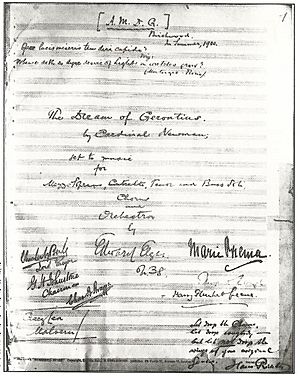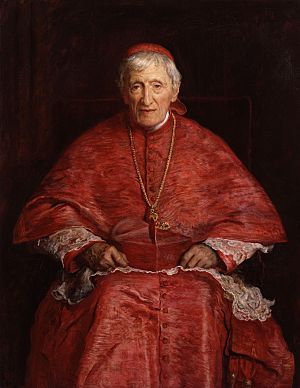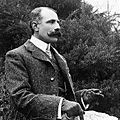The Dream of Gerontius facts for kids

The Dream of Gerontius is a big musical piece. It's for a choir, three solo singers, and an orchestra. Edward Elgar wrote it in 1900. It's often called an oratorio, which is a large musical work for orchestra, choir, and soloists, usually based on a religious story. However, Elgar himself didn't really like it being called that. Many people think it's the best choral work Elgar ever created.
The words for the music come from a long poem by John Henry Newman. The poem is about a man named Gerontius who is dying. He imagines what will happen to him after he dies, like meeting God and being judged to see if he can go to heaven. An angel talks to him in the poem. There's also a priest and a short part for the Angel of Agony. The whole piece is split into two parts. Part I is about 40 minutes long, and Part II is about an hour.
Contents
First Performances
This musical work was written for the Birmingham Music Festival in 1900. The very first time it was performed was on October 3, 1900, in Birmingham Town Hall. There were some problems at this first show. The person in charge of teaching the choir died while they were learning the music. The choir found some of the music very hard and strange. Also, the solo singers weren't very good. Even the conductor, Hans Richter, who was excellent, found it hard to keep the choir singing in tune. Richter didn't have enough time to get ready, as he only got the full music score the day before the first practice.
The next year, the work was performed in Germany and people really liked it there. It took a bit longer for it to become popular in England. This was partly because the ideas in the poem came from Roman Catholic teachings. John Henry Newman, who wrote the poem, was a Roman Catholic Cardinal. Because of this, many Anglican cathedrals didn't want it performed. So, some changes were made to the words. This new version was used at the Three Choirs Festival until 1910. After that, it quickly became very popular in England. It was also performed in Chicago and New York in 1903, and then in many other cities around the world.
A few years before Elgar wrote his piece, it was suggested that Antonín Dvořák should write music for "The Dream of Gerontius" for the Birmingham Festival. But they decided the poem was "too Catholic" for them at the time.
The Solo Singers
There are three main solo singers in The Dream of Gerontius. The most important singer is the tenor soloist. He sings the words of Gerontius, the dying man. There is also a bass singer who sings the part of the Priest. A mezzo-soprano sings the part of the angel. The Angel of the Agony can be sung by the same bass singer who sings the Priest. Sometimes the choir splits into two groups. There is also a small group of higher voices called the "semi-chorus."
The Story of the Poem

Newman's poem tells the story of a soul's journey after death. It explores ideas from Roman Catholic beliefs about the unseen world. The name Gerontius comes from the Greek word geron, which means "old man." The name "Gerontius" is not actually sung in the music. Elgar didn't use all of Newman's poem. He left out many of the meditations in Part 2. This was to stop the piece from being too long.
In the first part, we hear Gerontius. He is very faithful to God. Sometimes he feels scared, but at other times he feels hopeful. A group of his friends, also called "assistants," join him in prayer. He dies peacefully. A priest and the assistants say goodbye as his soul begins its journey.
In the second part, Gerontius, now called "The Soul," wakes up. He is in a place that seems to have no space or time. He realizes his guardian angel is there. The angel is happy because her job of bringing Gerontius to God is done. (In Newman's poem, the angel is male, but Elgar made the angel female and gave the part to a female singer.) They have a long talk. After that, they travel to God's throne for judgment. They have to pass by demons along the way. They also meet a choir of angels who are praising God. The Angel of the Agony asks Jesus to protect the souls of those who are faithful. Finally, Gerontius briefly sees God and is judged in just one moment. The Guardian Angel then gently places Gerontius into the calming lake of Purgatory. She gives him a final blessing and promises that he will wake up in glory.
The Orchestra
Elgar wrote the music for a large orchestra. Besides the usual instruments, it includes a piccolo, cor anglais, contrabassoon, harp, and organ.
The Music Style
The music is written in a late Romantic style. It was clearly inspired by the composer Richard Wagner, especially his opera Parsifal. The beginning of The Dream of Gerontius has a long orchestral introduction. This part uses musical ideas that will be important throughout the whole work. The music for Gerontius himself sometimes sounds like speech. But often, it is very beautiful and flowing. Elgar quickly changes between these two styles. The choir sings wonderful parts that reflect what is happening in the story. The choir of angels singing "Praise to the Holiest in the Height" is especially lovely. The part for the chorus of demons is very difficult to sing.
Images for kids
-
Notable Gerontius soloists: Edward Lloyd and Marie Brema (top); Gervase Elwes and Elena Gerhardt (below)





